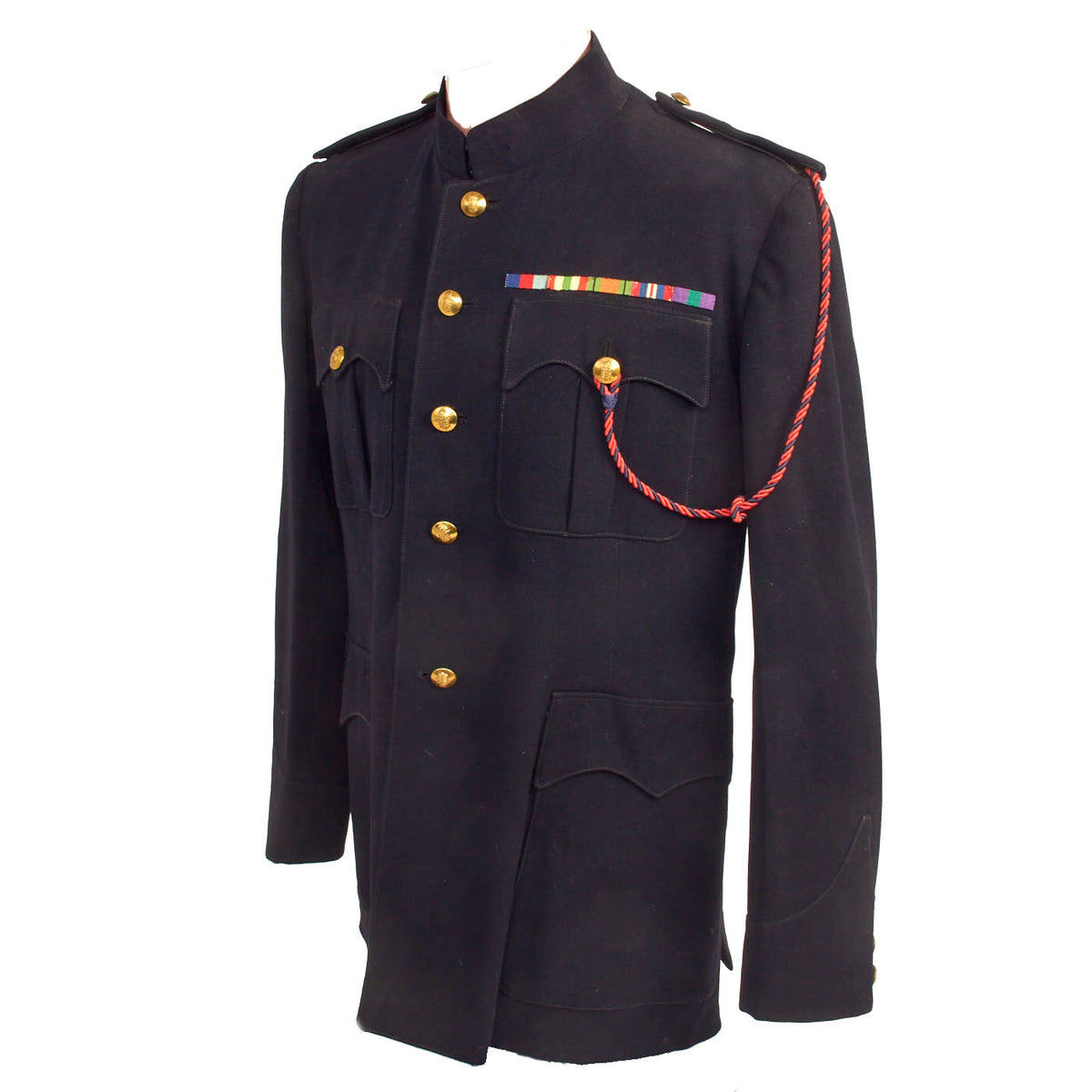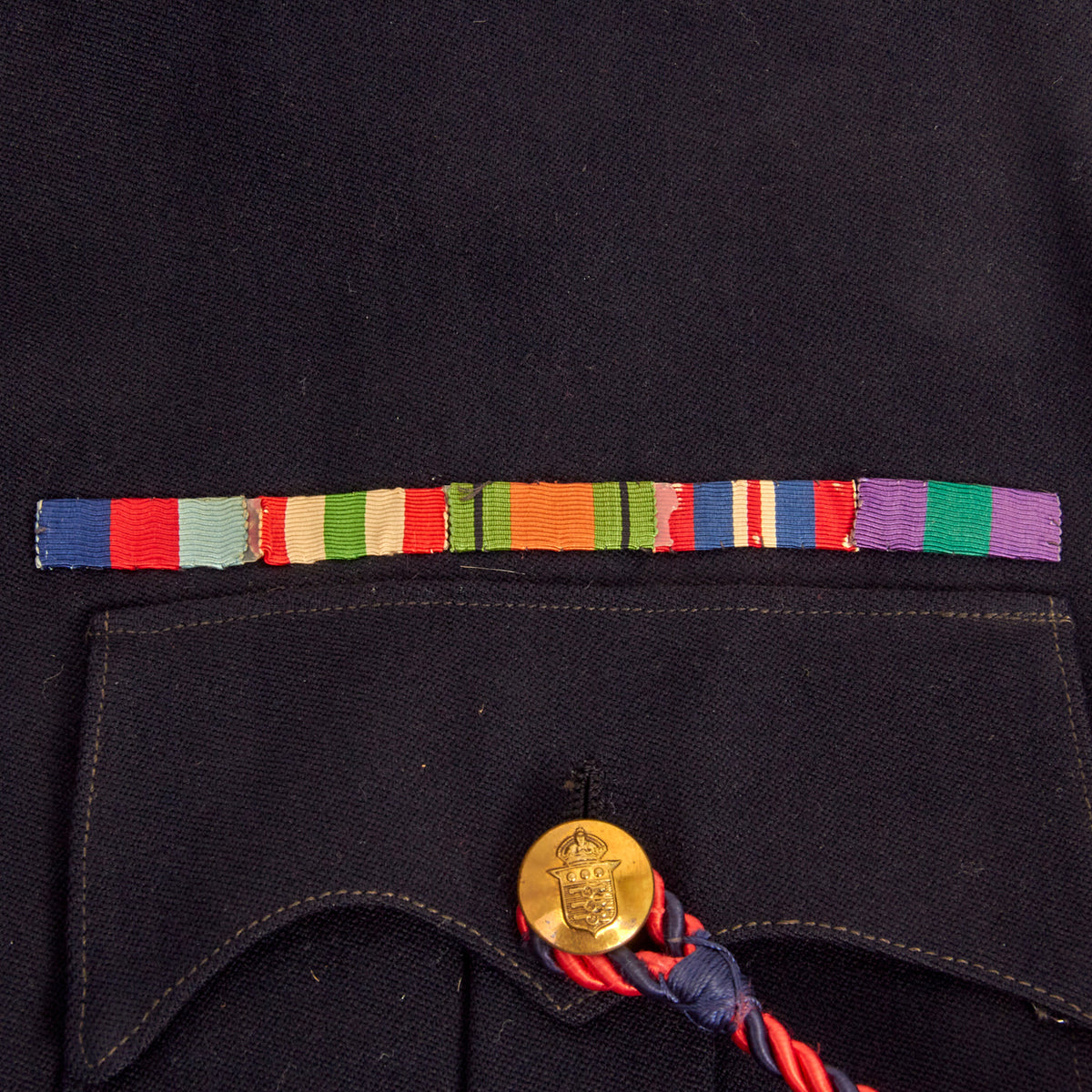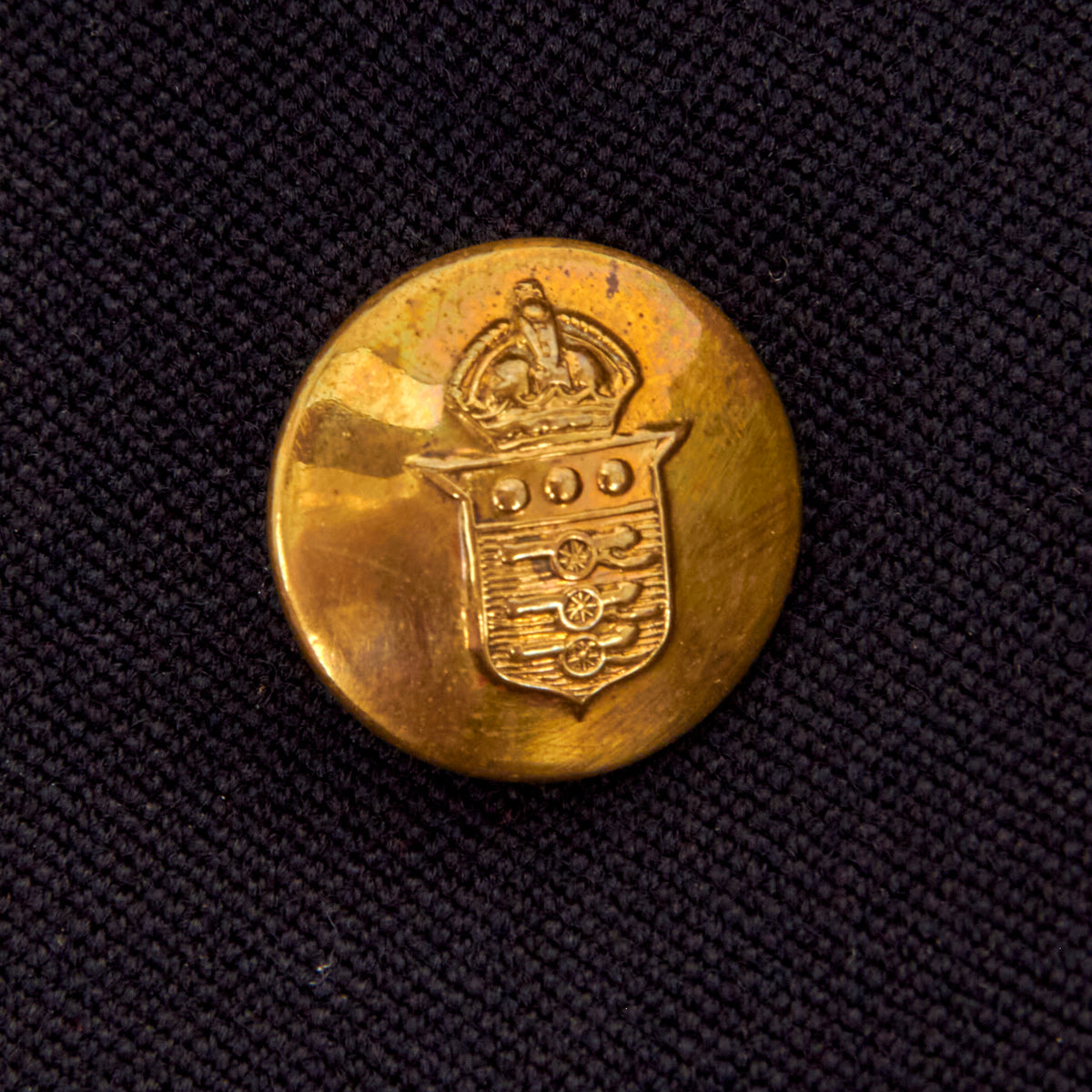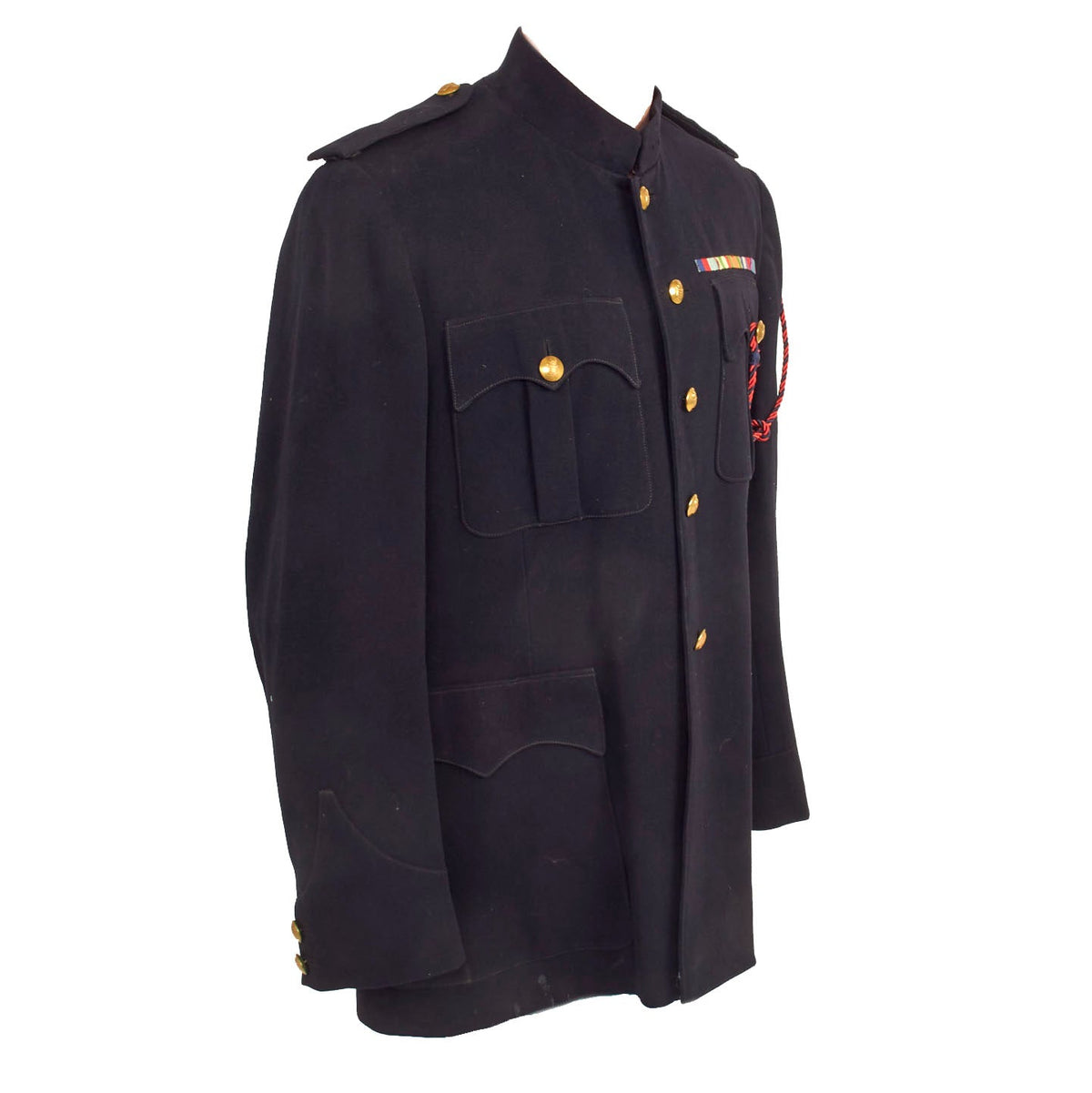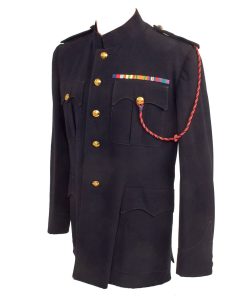Original British WWII Royal Army Ordnance Corps Patrol Jacket Original Items
$ 50,00 $ 30,00
Original Item: Only One Available. Dating from World War Two or just after this is a Royal Army Ordnance Corps Patrol Jacket with medal ribbons and Kings Crown Buttons offered in very good condition.
Approximate Measurements:
Collar to shoulder: 10”
Shoulder to sleeve: 26”
Shoulder to shoulder: 18”
Chest width: 21”
Waist width: 20”
Hip width: 25”
Front length: 32″
The Royal Army Ordnance Corps (RAOC) was a corps of the British Army. At its renaming as a Royal Corps in 1918 it was both a supply and repair corps. In the supply area it had responsibility for weapons, armored vehicles and other military equipment, ammunition and clothing and certain minor functions such as laundry, mobile baths and photography. The RAOC was also responsible for a major element of the repair of Army equipment. In 1942 the latter function was transferred to the Royal Electrical and Mechanical Engineers (REME) and the vehicle storage and spares responsibilities of the Royal Army Service Corps were in turn passed over to the RAOC.
After the war there was considerable retrenchment. In the 1920s the RAOC’s principal depots were Bramley (ammunition), Chilwell (general and surplus stores), Hereford (ammunition), Pimlico (clothing), Woolwich (gun stores and ammunition) and Weedon (small arms).[6] In 1922 the RAOC headquarters, regimental depot and School of Instruction moved from Woolwich to Hilsea Barracks on the edge of Portsmouth. (The School provided education and training in all aspects of the Corps’ work, with the exception of ammunition which was taught at Bramley, where the Army School of Ammunition was opened that same year.) The Royal Army Clothing Depot, Pimlico, closed in 1932 and its stock was mostly transferred to Didcot.
In the 1930s re-armament and the mechanisation of the Army led to a redesign of the UK base. A Central Ordnance Depot (COD) and workshop to support vehicles, built on the site of the First World War National Shell Filling Factory, Chilwell, opened in 1937. The operation of this depot was notable in that it mirrored and tried to improve on best civilian practice at the time; this became a hallmark of RAOC development in the following decades. COD Branston was established in 1938, initially to serve as the Army’s main clothing store, freeing up space at COD Didcot. At the outbreak of the Second World War there were five CODs: Branston, Chilwell, Didcot, Weedon and Woolwich.
Woolwich was prone to aerial bombardment, so from September 1939 the War Department leased part of an industrial estate in Greenford, which provided 632,000 square feet of covered accommodation. A further COD to hold non-vehicle technical stores opened at Donnington, Shropshire in 1940 (in order to remove critical items from Woolwich to a less vulnerable site) and purpose-built depots for both tracked and wheeled vehicles were opened across the country. Woolwich then ceased operating as a COD (though by the end of 1942 it was again being used for bulk storage, albeit as a sub-depot of COD Greenford).
In the 1930s virtually all the Army’s stockpile of ammunition was held at Bramley, which was vulnerable to air attack, so three new Central Ammunition Depots (CAD) were built: Serving south, central and northern England respectively, these were CAD Monkton Farleigh, Wiltshire (also known as CAD Corsham, an underground depot); CAD Nesscliffe, Shropshire; and CAD Longtown, Cumbria. By 1942 more storage capacity was required and another CAD was opened: Kineton. That same year a very large COD, widely spread out across the Oxfordshire countryside to mitigate the risk of bomb damage, opened at Bicester to hold stores principally to support the invasion of France.
Forward of the UK base, a huge array of temporary depots were built to meet the rapidly changing pace of war. Base Ordnance Depots (BOD) and Base Ammunition Depots (BAD) sprung up all over the world wherever a major line of communication was established.
Major changes took place after 1942 when the Royal Electrical and Mechanical Engineers (REME) absorbed most of the RAOC repair functions and the RAOC in turn took over the RASC’s vehicle organisation. The more mobile nature of the Second World War also led to the creation of units at divisional and corps level with higher levels of mobility. The most notable of these was the ordnance field park, principally carrying vehicle and technical stores spares.
Fast Shipping with Professional Packaging
Thanks to our longstanding association with UPS FedEx DHL, and other major international carriers, we are able to provide a range of shipping options. Our warehouse staff is expertly trained and will wrap your products according to our exact and precise specifications. Prior to shipping, your goods will be thoroughly examined and securely secured. We ship to thousands clients each day across multiple countries. This shows how we're dedicated to be the largest retailer on the internet. Warehouses and distribution centres can be located throughout Europe as well as the USA.
Note: Orders with more than one item will be assigned a processing date depending on the item.
Before shipping before shipping, we'll conduct a thorough inspection of the items you have ordered. Today, the majority of orders will be delivered within 48 hours. The delivery time will be between 3-7 days.
Returns
The stock is dynamic and we cannot completely manage it because multiple stakeholders are involved, including our factory and warehouse. So the actual stock may alter at any time. It's possible that you may not receive your order once the order has been made.
Our policy is valid for a period of 30 days. If you don't receive the product within 30 days, we are not able to issue a refund or an exchange.
You can only return an item if it is unused and in the same state as the day you received it. You must have the item in its original packaging.
Related products
Uncategorized
Australian WWII Owen MK1 Machine Carbine SMG Custom Fabricated Replica with Sling Original Items
Uncategorized
Uncategorized
Uncategorized
Uncategorized
Band of Brothers ORIGINAL GERMAN WWII Le. F.H. 18 10.5cm ARTILLERY PIECE Original Items
Uncategorized
Uncategorized
Uncategorized
Uncategorized
Uncategorized
Uncategorized
Uncategorized
Angolan Rebel 1970s era 60mm Inert Display Mortar from Angolan Civil War Original Items
Uncategorized
Uncategorized
Uncategorized
Uncategorized
Uncategorized
Uncategorized
Uncategorized
